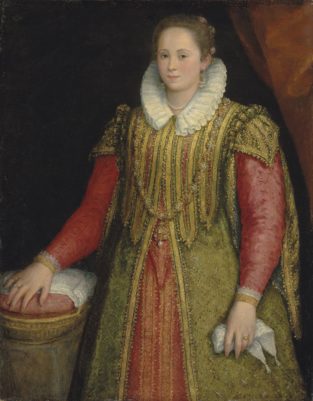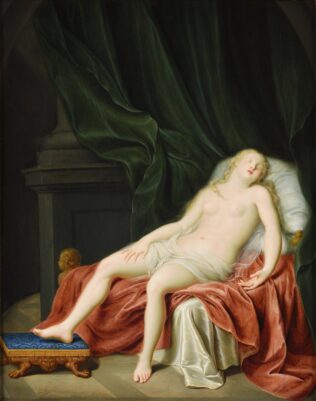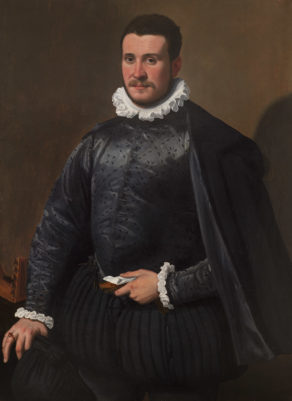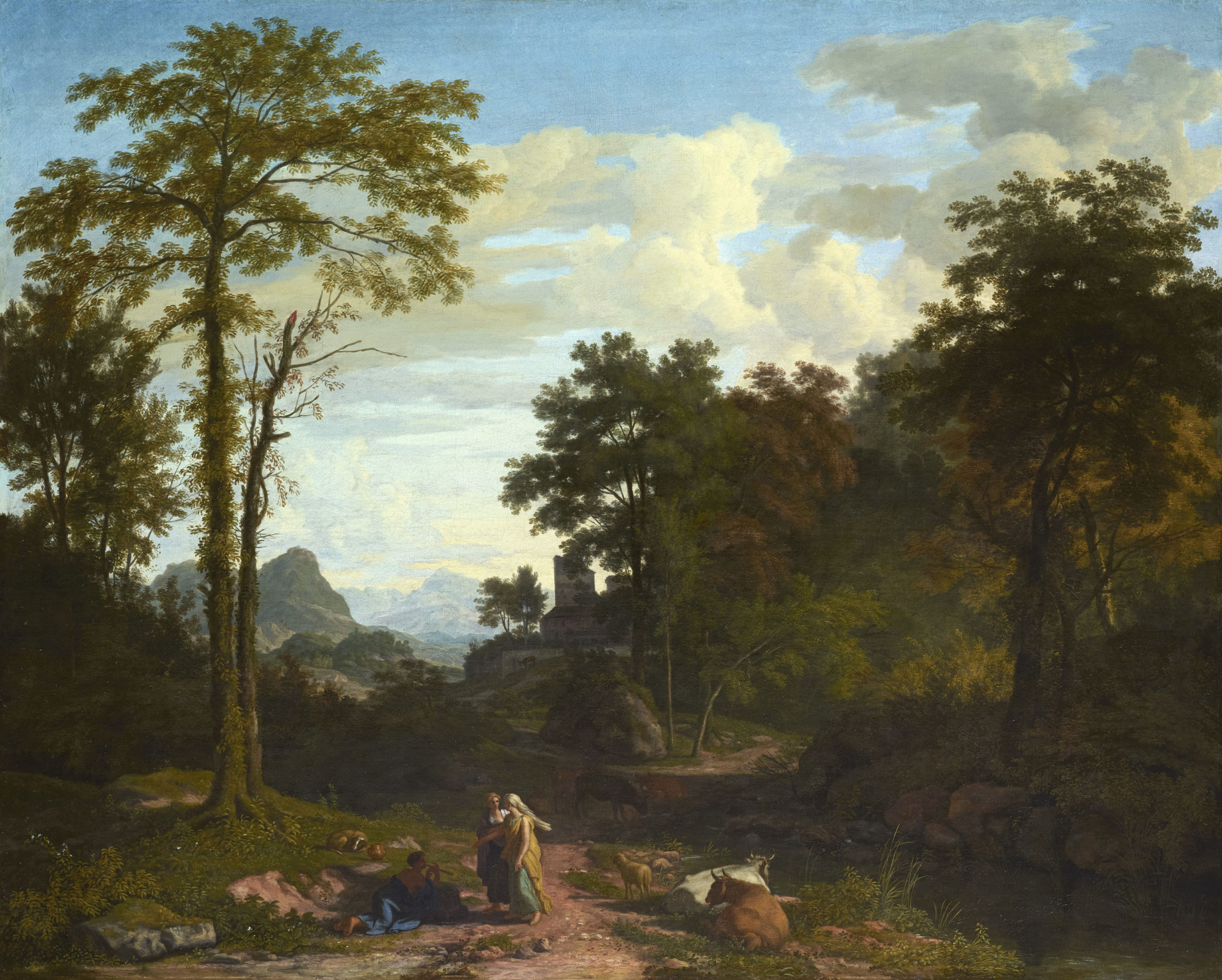
Johannes Glauber and Gérard de Lairesse
A Southern Landscape with Travellers in front of a Fortified Town
Provenance:
Sale, Sotheby’s, London, 20 April 1988, lot 125.
Sale, Dorotheum, Vienna, 23 October 2018, lot 103, when acquired by the present owner.
Catalogue Entry
A luminous, arcadian landscape appears before our eyes, pervaded by a serene atmosphere. At the centre, two young women dressed all’antica have stopped their journey along a stony pathway, attracted by the figure of a young man, probably a shepherd, who plays the flute while lying on the ground, his elbows leaning on a rock. The figure in green and yellow points towards him with her right arm stretched, while her female companion tries to draw her away from the music by grabbing her arm tight. The group of figures is surrounded by animals: from left to right are a dog sleeping near a small bronze urn, a solitary standing sheep and two cows resting on the ground near a pond. As the eye proceeds into the landscape, it meets another group of cows and a fortified town built at the feet of a verdant hill. In the background, a bright blue sky with clouds illuminates the staggering mountains.
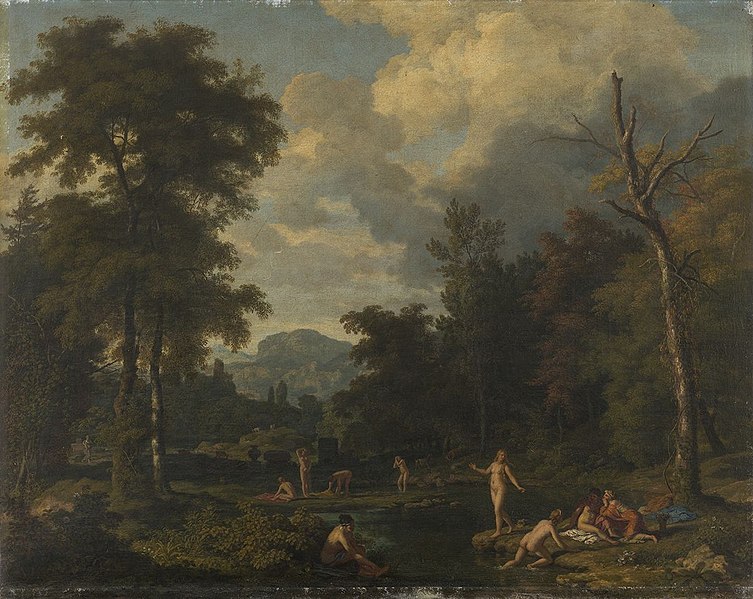
Fig. 1. Johannes Glauber, Landscape with Bathing Nymphs, oil on canvas, 89 x 113 cm, Bavarian State Painting Collection, Munich.
A Southern Landscape with Travellers in front of a Fortified Town resulted from the collaboration between Dutch painters Johannes Glauber (1646–c.1726) and Gérard de Lairesse (1641–1711).1 The former belonged to the last generation of Italianate Dutch and Flemish landscapists, whose work is indebted in the great painters of the tradition, i.e. Nicolas Poussin (1594–1665), Claude (1600–1682), and, particularly, Gaspard Dughet (1615–1675) and Salvator Rosa (1615–1673). Following a nine-month apprenticeship in Amsterdam with Nicolas Berchem (1620–1683), and some years spent working in Paris and Lyon, Glauber moved to Rome in 1675, two years after Rosa’s death and at the very end of Dughet’s life. In the city, he joined the Bentvueghels, a society of Dutch and Flemish artists founded in 1620, which included painters like Abraham Genoels (1640–1723), Johan Gottlieb (1656–1703) and Albert Meyeringh (1645–1714), who gave Glauber the nickname of “Polidoro” (in recognition of his debt to the landscapes of Polidoro da Caravaggio). Two years later, Glauber moved to Northern Italy, sojourning in Padua and Venice, and subsequently lived in Hamburg until 1684, when he returned to Amsterdam. In that year, the artist is documented sharing a house with de Lairesse, with whom he collaborated on the pictorial decoration of numerous mansions in both Amsterdam and Rotterdam, including that of silk merchant Jacob de Flines (1657–1714).2

Fig. 2a. Johannes Glauber, Landscape with Shepherd and Flute Player, oil on canvas, 195 x 249 cm, Musée du Louvre, Paris.

Fig. 2b. Detail of Fig. 2a.
When working together on landscape paintings, Glauber usually executed the natural setting, while de Lairesse was in charge of the figures and the classical elements, as was probably the case of the present work. The vastity and luminosity of the landscape are distinctive of Glauber’s production from the late 1680s, a moment when he had fully assimilated Poussin’s classicism through the lenses of Dughet. This is exemplified by the choice of a foreground inhabited by figures and suffused with warm afternoon sunlight, the use of trees as framing elements, and the relatively low horizon, which lays emphasis on the wideness of the sky. Despite his adherence to French and Italian landscape traditions, in the present work, Glauber combined them with Northern scenery, the flora and the crisp blue cloudy sky recalling North European sites rather than the Roman countryside.
The landscape is imaginary and idealised, yet Glauber reserved particular attention to realistic details, such as the verdant moss in the foreground and the weeds scattered along the stony path. Two truncated tree trunks on the left and right sides of the painting attest the artist’s acknowledgement of the variety of the natural world, which he had extensively studied by drawing it from life while living in the Veneto. As sometimes suggested in relation to Glauber’s landscapes, the contrast between the dead trunks and the apparently incorruptible vegetation all around might symbolise the fragility of all living things.3 The cut tree trunk is a recurring motif in the painter’s oeuvre, the one on the left reappearing, similar, in Landscape with Bathing Nymphs (Bavarian State Painting Collection, Munich, Fig. 1) and in Landscape with Shepherd and Flute Player, today at the Louvre (Fig. 2a and 2b). The intersecting trunks on the right are also a favoured motif with Glauber, which can also be found in the work of coeval Dutch Italianate landscapists, primarily Frederik de Moucheron (1633–1686, Fig. 3), with whom Glauber often collaborated.4 The repetition of similar elements across different paintings also extends to the imaginary town and the pointy mountain in the background, which Glauber possibly derived from Dughet and used in his paintings on several occasions, as in one of the landscapes he painted with de Lairesse for de Flines’ mansion (Rijksmuseum, Amsterdam, Fig. 4).

Fig. 3. Frederik de Moucheron, Southern Landscape with Hunter and Deer, oil on canvas, 72 x 89 cm., Staatliche Kunsthalle, Karlsruhe.
The bronze urn, a decorative and artificial element within the painting, references classical antiquity, as also do the figures. Painted by de Lairesse, they have not been identified with specific mythological or literary characters, but rather allude to an idyllic Arcadia. The scene might be a classicizing reinterpretation of a very common iconography in Dutch seventeenth-century painting, i.e. the amorous interaction between a shepherd playing the flute and a young woman.5 Similar figures can be found, for example, in Glauber’s aforementioned Louvre painting (Fig. 2.b). The fact that one of the two women is unusually drawing the other away from the playing shepherd might suggest an allegorical reading of the scene, perhaps as a warning against lust, a theme often associated with pastoral encounters.6
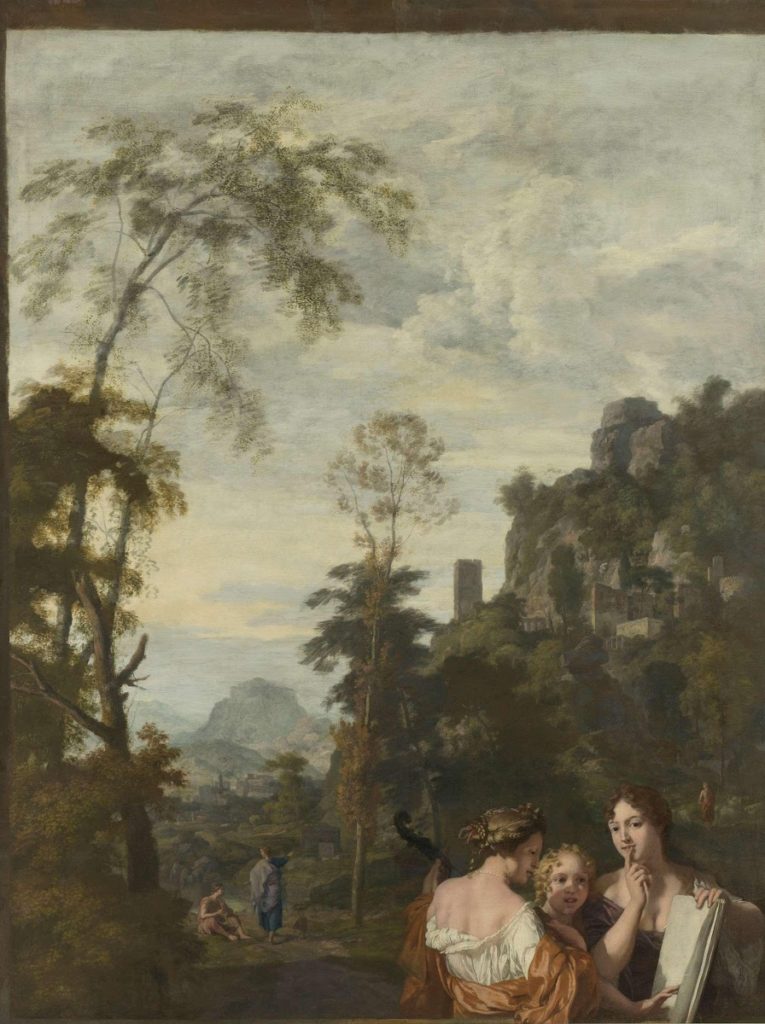
Fig. 4. Johannes Glauber and Gérard de Lairesse, Italianate Landscape with three Women Making Music, oil on canvas, 282 x 217 cm., Rijksmuseum, Amsterdam.
Although de Lairesse’s contribution to A Southern Landscape seems restricted to the execution of the urn and the figures, it actually goes far beyond. In the last decades of the seventeenth century, de Lairesse had been the principal Dutch advocate for Italian classicism and for a return to the antique in painting, through both his works and theoretical discourse, which he summarised in his famous 1707 book Het Groot Schilderboek. His inclusion of an urn amidst nature visualises his belief that “nature becomes perfect and heroic when wisely embellished of ancient monuments that, along with her beautiful products, make up a whole that we can define a landscape of antique taste.”7 De Lairesse’s theories greatly informed Glauber’s conception of landscape painting. The latter indeed embraced the former’s reaction to mere naturalism, and followed his advice to research grace in the natural world, to perfect nature by selecting its most beautiful parts, as he did in the present work. The aforementioned realistic elements included by Glauber in his harmonious, benevolent landscape attests to a subtle degree of subjectivity, which make his paintings stand out in the art of his time and mark the transition into the eighteenth century.
1 For a concise biography of the artist, see Walter A. Liedtke, Dutch Paintings in the Metropolitan Museum of Art, Vol. 1-2 (New York: Metropolitan Museum of Art), p. 414. 2 For a concise biography of Johannes Glauber, see Pittori di paesaggio del Seicento a Roma, Vol. II, (Rome: Bozzi, 1978), p. 828. 3 Bernard Biard, “Johannes Glauber. L’Art des Paysages Arcadiens à la Fin du XVIIème Siècle,” in L’Estampille/L’Objet d’Art, Vol. 371, July-August 2002, pp. 53-54. 4 Ibid., p. 61. 5 Lara Yeager-Crasselt, “Elegant Shepherdess Listening to a Shepherd Playing the Recorder in an Arcadian Landscape,” in The Leiden Collection Catalogue, 3rd ed, edited by Arthur K. Wheelock Jr. and Lara Yeager-Crasselt (New York, 2020). 6 See, for example, Pastoral Scene by Abraham Bloemaert, today in the Landesmuseum, Hannover. 7 Biard, “Johannes Glauber,” p. 57.
Condition:
The painting has recently been restored.
